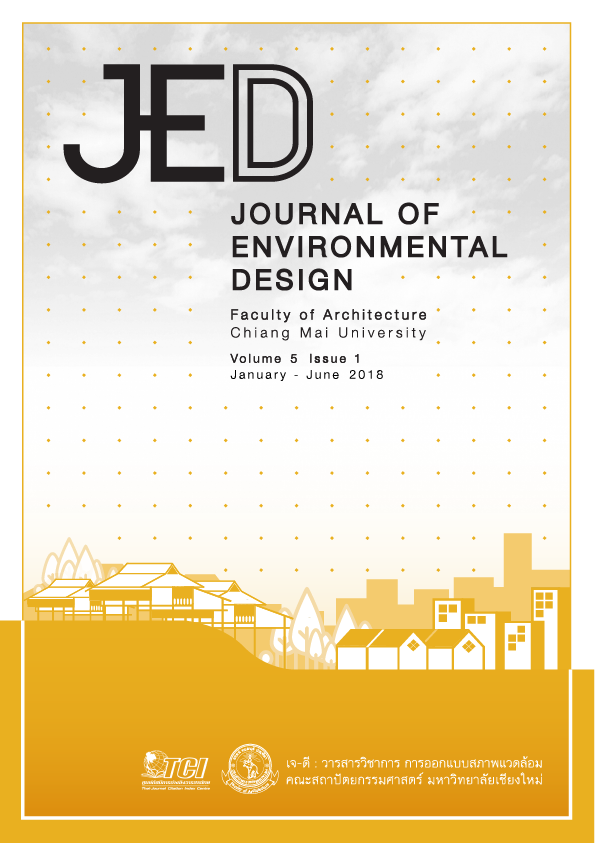พลวัตสถาปัตยกรรมพื้นถิ่นลาหู่ในพื้นที่ภาคเหนือตอนบนของประเทศไทย
Main Article Content
บทคัดย่อ
บทความนี้สังเคราะห์ผลวิจัยในกลุ่มหัวข้อ พลวัตสถาปัตยกรรมในอาเซียน เกี่ยวกับสถาปัตยกรรมพื้นถิ่นลาหู่และการเปลี่ยนแปลงในพื้นที่ภาคเหนือตอนบนของประเทศไทย จังหวัดเชียงใหม่ และเชียงราย กรณีศึกษา หมู่บ้านขอบด้ง อำเภอฝาง จังหวัดเชียงใหม่ และหมู่บ้านห้วยน้ำริน อำเภอเวียงป่าเป้า จังหวัดเชียงราย ทั้งสองหมู่บ้านที่เลือกศึกษาตั้งอยู่บนพื้นที่ลาดเชิงเขา และมีรูปแบบสถาปัตยกรรมที่หลากหลายทั้งดั้งเดิมและแบบสมัยใหม่ ได้ตั้งโจทย์การศึกษาในเรื่อง ปัจจัยการเปลี่ยนแปลงของลักษณะสถาปัตยกรรมพื้นถิ่นในประเทศไทย โดยเฉพาะกลุ่มชาติพันธุ์ลาหู่ ทำการศึกษาปัจจัยครอบคลุมนโยบายการพัฒนาจากภาครัฐ และการส่งเสริมอาชีพจากศูนย์พัฒนาโครงการหลวง รวมถึงองค์กรต่างๆ จากการเปลี่ยนแปลงทางสังคม การเปลี่ยนแปลงวิถีชีวิต การเกษตร การดำรงไว้ซึ่งชาติพันธุ์ของตน เพื่อหาความเชื่อมโยงถึงสาเหตุแห่งการเปลี่ยนแปลง ผลการวิจัยครั้งนี้ชี้ให้เห็นถึงสภาพสังคมและวิถีชีวิตที่เปลี่ยนไปอย่างรวดเร็วของวิทยาการสื่อสารของโลกาภิวัตน์ในประเทศไทย ส่งผลต่อการเปลี่ยนแปลงลักษณะที่อยู่อาศัยซึ่งเป็นสิ่งที่หลีกเลี่ยงไม่ได้ นอกจากนี้การรับเอาวัฒนธรรมการปลูกสร้างเรือนแบบอย่างคนไทยเข้าไปประยุกต์กับเรือนลาหู่ ทำให้ในปัจจุบันเรือนลาหู่มีรูปแบบเปลี่ยนแปลงไปจากเดิม จากเรือนแบบดั้งเดิมไปเป็นเรือนแบบสมัยใหม่ จนแทบไม่เหลือเค้าโครงของเรือนแบบดั้งเดิม เนื่องมาจากปัจจัยที่เกิดขึ้นทั้งจากปัจจัยภายในและปัจจัยภายนอก แต่สิ่งสำคัญที่ได้จากการศึกษาชี้ให้เห็นถึงคุณค่าของงานสถาปัตยกรรมพื้นถิ่นของกลุ่มชาติพันธุ์ที่ยังคงมีคุณค่าทางด้านศิลปะ สะท้อนถึงวิถีชีวิตและวัฒนธรรมของลาหู่
Article Details
เอกสารอ้างอิง
Jarasakon, L. (2014). Sathapattayakam phuenthin Lahu lae karn plian plaeng nai phuen tee phaknuea ton bon khong Thai. (In Thai) [Vernacular archiัะพ tecture of Lahu and the change in Upper northern areas] (Master’s thesis). Chiang Mai: Faculty of Architecture, Chiang Mai University.
Office of the Royal Society. (2012). Phojananukrom chabap Ratchabandittayasathan (in Thai) [Royal institute dictionary]. Bangkok: Nanmee Publications.
Sateerasinlapin, S. (1984). Panha karn sueksa khong chaokao phao Musoe nai boriwen doi Musoe Changwat Tak. (In Thai) [The problem of the Lahu tribe in Doi Muser, Tak province] (Master’s thesis). Bangkok: Mahidol University.
Sirisai, S. (1999). Saranukrom klum chat ti phan Lahu. (In Thai) [Encyclopedia of Lahu ethnic groups]. Bangkok: Institute of Language and Culture for Rural Development, Mahidol University.
Sisuro, V. (2000). Sathapattayakam phuenthin nan samkhan chanai nai khwam laklai nai ruean phuenthin Thai. (In Thai) [Significance of vernacular architecture in the diversity of Thai traditional houses]. Bangkok: Silpakorn University.
Walker R. A., (Ed.). (1995). Mvuh Hpa Mi Hpa: creating heaven, creating earth: an epic myth of the Lahu people in Yunnan. Chiang Mai: Silkworm Books.
Wongprasert, S. (1983). Ban Muser. (In Thai) [Muser House]. Chiang Mai: Tribal Research and Cultural Institute.


